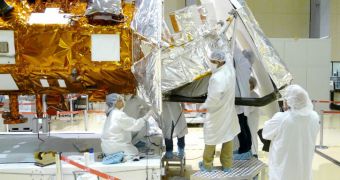The assembly of the Aquarius/Satelite de Aplicaciones Cientificas (SAC-D) spacecraft, a collaboration between the United States and Aregentina, is going on schedule, experts announce. Technicians have installed the satellite's thermal blankets last week, and are now getting ready to move forward.
At this point, the insulated spacecraft is undergoing varied functional performance tests, which are being conducted at the National Institute for Space Research (Laboratório de Integração e Testes – Instituto Nacional de Pesquisas Espaciais), in Brazil.
The LIT-INPE facility is located in Sáo José dos Campos. On the American end of the collaboration, experts at the NASA Jet Propulsion Laboratory (JPL) are refining the Aquarius instrument, calibrating it for optimal performance in orbit.
All work and tests on the spacecraft and its components needs to be done by March, when the satellite needs to be delivered to the Vandenberg Air Force Base (VAFB), in California. Launch is scheduled to occur in early June from this facility.
The Aquarius instrument that JPL built will have to measure changes in salinity that affect the global ocean. Additionally, it will have to create maps of ocean salinity on a monthly basis, providing updates for relevant agencies interested in using such data.
In addition to the immediate, practical applications, understanding oceanic salinity is also important for gaining more insight into the intricacies underlying the planet's water cycle.
Oceanic circulation could also make more sense to scientists following long-term studies of salinity, too. At this point, the SAC-D spacecraft is scheduled to remain in orbit for at least three years.
In addition to Aquarius, the satellite will also carry an infrared imaging system for detecting oceanic temperatures, a cosmic radiation detector, as well as a technology demonstration payload involving GPS navigation and inertial guidance, among others.
The Argentina space agency, called the Comisión Nacional de Actividades Espaciales (CNAE) deals with developing the satellite and the main bus, whereas NASA and the JPL play more active roles in putting together the instrumentation required for the job.
Aquarius, the primary science payload on SAC-D, was designed and built by JPL experts, in cooperation with colleagues in Greenbelt, Maryland, at the NASA Goddard Space Flight Center (GSFC).

 14 DAY TRIAL //
14 DAY TRIAL //